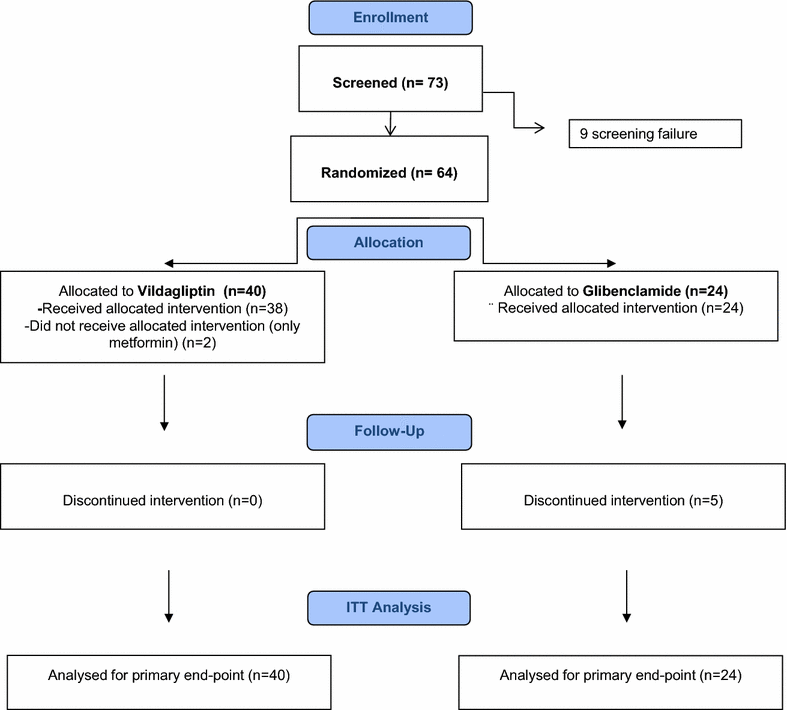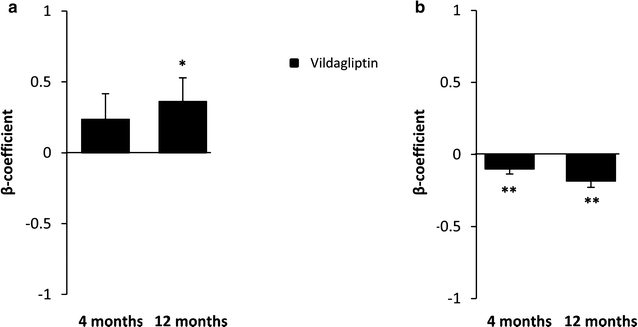Vildagliptin, but not glibenclamide, increases circulating endothelial progenitor cell number: a 12-month randomized controlled trial in patients with type 2 diabetes
- PMID: 28231835
- PMCID: PMC5324295
- DOI: 10.1186/s12933-017-0503-0
Vildagliptin, but not glibenclamide, increases circulating endothelial progenitor cell number: a 12-month randomized controlled trial in patients with type 2 diabetes
Abstract
Background: Fewer circulating endothelial progenitor cells (EPCs) and increased plasma (C-term) stromal cell-derived factor 1α (SDF-1α), a substrate of DPP-4, are biomarkers, and perhaps mediators, of cardiovascular risk and mortality. Short-term/acute treatment with DPP-4 inhibitors improve EPC bioavailability; however, long-term effects of DPP-4i on EPCs bioavailability/plasma (C-term) SDF-1α are unknown.
Methods: Randomized (2:1) open-label trial to compare the effects of vildagliptin (V) (100 mg/day) vs glibenclamide (G) (2.5 mg bid to a maximal dose of 5 mg bid) on circulating EPC levels at 4 and 12 months of treatment in 64 patients with type 2 diabetes in metformin failure. At baseline, and after 4 and 12 months, main clinical/biohumoral parameters, inflammatory biomarkers, concomitant therapies, EPC number (CD34+/CD133+/KDR+/106 cytometric events) and plasma (C-term) SDF-1α (R&D system) were assessed.
Results: Baseline characteristics were comparable in the two groups. V and G similarly and significantly (p < 0.0001) improved glucose control. At 12 months, V significantly increased EPC number (p < 0.05) and significantly reduced (C-term) SDF-1α plasma levels (p < 0.01) compared to G, with no differences in inflammatory biomarkers.
Conclusions: V exerts a long-term favorable effect on EPC and (C-term) SDF-1α levels at glucose equipoise, thereby implying a putative beneficial effect on vascular integrity. Trial registration Clinical Trials number: NCT01822548; name: Effect of Vildagliptin vs. Glibenclamide on Circulating Endothelial Progenitor Cell Number Type 2 Diabetes. Registered 28 March, 2013.
Keywords: Cardiovascular risk; DPP-4 inhibitors; EPC; SDF-1α.
Figures



Similar articles
-
Vildagliptin reduces plasma stromal cell-derived factor-1α in patients with type 2 diabetes compared with glimepiride.J Diabetes Investig. 2017 Mar;8(2):218-226. doi: 10.1111/jdi.12572. Epub 2016 Oct 12. J Diabetes Investig. 2017. PMID: 27575011 Free PMC article. Clinical Trial.
-
Effects of vildagliptin compared with glibenclamide on glucose variability after a submaximal exercise test in patients with type 2 diabetes: study protocol for a randomized controlled trial, DIABEX VILDA.Trials. 2014 Nov 4;15:424. doi: 10.1186/1745-6215-15-424. Trials. 2014. PMID: 25366037 Free PMC article. Clinical Trial.
-
Effects of Sitagliptin on the Coronary Flow Reserve, Circulating Endothelial Progenitor Cells and Stromal Cell-derived Factor-1alpha.Intern Med. 2019 Oct 1;58(19):2773-2781. doi: 10.2169/internalmedicine.2616-19. Epub 2019 Jun 27. Intern Med. 2019. PMID: 31243210 Free PMC article.
-
The DPP-4 inhibitor vildagliptin: robust glycaemic control in type 2 diabetes and beyond.Diabetes Obes Metab. 2007 Sep;9 Suppl 1:32-9. doi: 10.1111/j.1463-1326.2007.00763.x. Diabetes Obes Metab. 2007. PMID: 17877545 Review.
-
Vildagliptin: a review of its use in type 2 diabetes mellitus.Drugs. 2014 Apr;74(5):587-610. doi: 10.1007/s40265-014-0199-3. Drugs. 2014. PMID: 24638989 Review.
Cited by
-
How to interpret the role of SDF-1α on diabetic complications during therapy with DPP-4 inhibitors.Cardiovasc Diabetol. 2018 Feb 2;17(1):22. doi: 10.1186/s12933-018-0668-1. Cardiovasc Diabetol. 2018. PMID: 29394900 Free PMC article. No abstract available.
-
Vildagliptin topical ointment: an effective treatment for imiquimod-induced psoriasis in mice.J Mol Histol. 2025 Apr 26;56(3):143. doi: 10.1007/s10735-025-10416-4. J Mol Histol. 2025. PMID: 40285915
-
Have dipeptidyl peptidase-4 inhibitors ameliorated the vascular complications of type 2 diabetes in large-scale trials? The potential confounding effect of stem-cell chemokines.Cardiovasc Diabetol. 2018 Jan 8;17(1):9. doi: 10.1186/s12933-017-0648-x. Cardiovasc Diabetol. 2018. PMID: 29310647 Free PMC article. Review.
-
Effect of DPP-4i inhibitors on renal function in patients with type 2 diabetes mellitus: a systematic review and meta-analysis of randomized controlled trials.Lipids Health Dis. 2024 May 25;23(1):157. doi: 10.1186/s12944-024-02132-x. Lipids Health Dis. 2024. PMID: 38796440 Free PMC article.
-
Teneligliptin, a DPP-4 Inhibitor, Improves Vascular Endothelial Function via Divergent Actions Including Changes in Circulating Endothelial Progenitor Cells.Diabetes Metab Syndr Obes. 2023 Apr 13;16:1043-1054. doi: 10.2147/DMSO.S403125. eCollection 2023. Diabetes Metab Syndr Obes. 2023. PMID: 37077576 Free PMC article. Clinical Trial.
References
Publication types
MeSH terms
Substances
Associated data
LinkOut - more resources
Full Text Sources
Other Literature Sources
Medical
Research Materials
Miscellaneous

